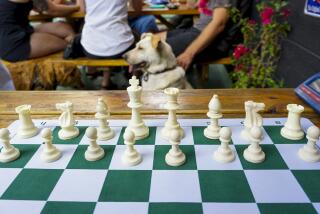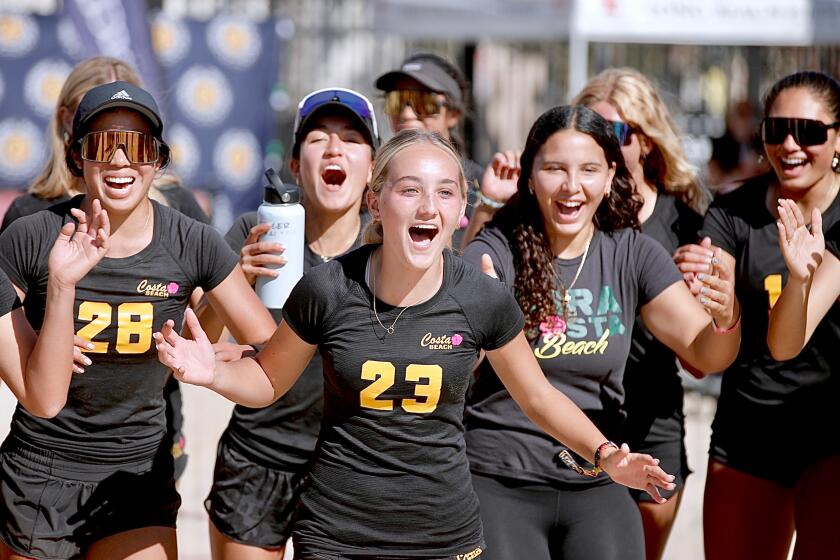Timur Gareyev wins National Open
- Share via
Timur Gareyev, an Uzbek grandmaster who attends the University of Texas in Brownsville, won the National Open last weekend in Las Vegas. Gareyev yielded a first-round draw to IM Joe Bradford of Texas but won his next five games. He was particularly tough on Southern Californians, inflicting defeats on IM Andranik Matikozyan and, in the final round, GM Varuzhan Akobian.
Tied for second at 5-1 were Akobian and GMs Arthur Kogan (Israel), Alex Lenderman (New York) and Alejandro Ramirez (Costa Rica). Matikozyan tied for sixth at 41/2-11/2. There were 19 GMs in the 105-player Open section.
Two Southern Californians, Danyul Lawrence and 12-year-old Michael W. Brown, shared first place with scores of 51/2-1/2 in the Under-2200 section. Former USC student Colin Field-Eaton tied for first in the Under-2000 section.
The total attendance of 693 players in the nine-section event is about average for one of the country’s most enduring chess traditions.
Candidates matches
Viswanathan Anand’s exciting victory over Veselin Topalov in the world championship last month ensured that he will remain champion until 2012. Who will be his next challenger?
The World Chess Federation (FIDE) plans three rounds of matches, beginning in March, to select the challenger. FIDE has already determined seven of the eight candidates. Topalov and the man he defeated in 2009 to become Anand’s challenger, U.S. champion Gata Kamsky, have qualified. So have World Cup winner Boris Gelfand (Israel), Grand Prix winner Levon Aronian (Armenia) and Grand Prix runner up Teimour Radjabov (Azerbaijan). FIDE chose two players by rating, current No. 1 Magnus Carlsen (Norway) and current No. 4 Vladimir Kramnik (Russia). The organizers will choose the eighth player, whose rating must be above 2700.
FIDE picked Baku, Azerbaijan, as the site for the matches, but it’s likely that another city will host some matches because Aronian has refused to play in Baku.
The quarterfinal and semifinal matches will last four games, and the final will be six games. Ties will be broken by four rapid (25-minute) games and, if necessary, up to five pairs of blitz (five-minute) games.
The prize fund will total at least 540,000 Euros (about $650,000). The winner earns a minimum of 90,000 Euros (about $108,000) plus the right to challenge Anand.
It appears that Topalov, the top seed, will play Kamsky (almost certainly the eighth seed) in the first round.
Local news
The Bakersfield Class Act II takes place next weekend at East Hills Mall in Bakersfield. For details of the five-round tournament and the accompanying scholastic event, see bakersfieldchessclub.com or call Kenneth Poole at (661) 304-7468.
Today’s games
GM Giorgi Kacheishvili (Republic of Georgia)-GM Loek Van Wely (Netherlands), Chicago Open, Wheeling 2010: 1 d4 d5 2 Nf3 Nf6 3 c4 c6 4 Nc3 e6 The Semi-Slav Defense to the Queen’s Gambit. 5 Bg5 h6 6 Bxf6 A quiet alternative to the gambit 6 Bh4 dxc4 7 e4 b5. Qxf6 7 e3 g6 8 Bd3 Bg7 9 0-0 0-0 10 Rc1 Nd7 11 cxd5 Other plans begin with 11 b4 and 11 e4. exd5 12 b4 The Minority Attack. White’s goal is to advance b4-b5, leaving Black with at least one vulnerable pawn. a6 13 Qb3 In Timman–Ponomariov, Carlsbad 2007, White saddled Black with a backward c-pawn by 13 a4 Qd6 14 Qb3 Nf6 15 b5 axb5 16 axb5 Be6 17 bxc6 bxc6, but Black easily held the draw. Nb6 14 a4 Now 14…Bf5 is adequate, but Black chooses a more combative response. Be6 Black intends to meet 15 b5 axb5 16 axb5 with 16…c5!? 17 dxc5 d4. 15 Ne5 Natural, but harmless. If White wants to defend c4, he should prefer 15 Nd2. Qe7 16 f4 Nd7 17 a5? Dreaming of Nc3-a4-c5. The humble 17 Ne2 would let him parry 17…Nxe5 18 fxe5 f6 with 19 Nf4. Nxe5! 18 fxe5 f6 Suddenly White is in serious trouble. His pawn at e3 is Black’s prime target. 19 exf6 White must avoid 19 Bxg6?! fxe5 20 dxe5? d4. Rxf6 20 Na4? Losing. Only 20 Rxf6 Qxf6 21 Rf1 Qg5 22 Rf3 hangs on. Bf7 21 Bc2 Re8 22 Rxf6 Bxf6 23 Kf2 Bg5 24 Re1 Black will demolish White’s flimsy defense with a fine combination. Qf6+ 25 Kg1 Bxe3+! 26 Rxe3 Qxd4 27 Kf2 Qd2+ 28 Kf3 Rf8! Threatening both 29…d4 and 29…Be6+ 30 Kg3 Qf2 mate. 29 Kg3 d4 30 Re6 Qg5+ 31 Kh3 Qh5+ 32 Kg3 Qg5+ 33 Kh3 h5!, White Resigns. Neither 34 Bd1 Qf5+ nor 34 Rxg6+ Qxg6 35 Bxg6 Bxb3 36 Nc5 Bf7 is worth playing.
GM Anatoly Lein-GM Ben Finegold, Chicago Open, Wheeling 2010: 1 e4 c5 2 Nf3 Nc6 3 Bb5 The Rossolimo Attack, now a very popular treatment of the Sicilian Defense. e6 4 Bxc6 bxc6 Black hopes to use his pair of Bishops and his mass of central pawns. 5 d3 White wants a closed position which would limit the Bishops without hampering the Knights. Ne7 6 Qe2 Ng6 7 h4 Qc7 8 g3 h5 9 b3 e5 10 Nbd2 d6 Black should take the plunge and advance 10…d5. 11 Nc4 Ne7?! Puzzling. Maybe Black intended to develop his Bishop to g7. 12 Nh2?! White will never achieve his desired f2-f4. He could keep equality, or a bit more, by 12 Bd2 f6 13 Ba5 Qb8 14 0-0-0 d5 15 Ne3. f6 To meet 13 f4?! with 13…d5!, chasing the Knight to a poor square. If 14 Nb2, Black can consider the pawn sacrifice 14…c4!?, as 15 dxc4 dxe4 16 Qxe4 Bf5 or 15 bxc4 exf4 16 gxf4 Rb8 opens lines for his Rook and Bishops. 13 Ne3 d5 14 c4?! Locking the center ought to favor White, but he will have little opportunity for activity. Better appears 14 0-0, still hoping for f2-f4. d4 15 Nd1 Ng6 16 Nb2 Bd6 17 Na4 Nf8! 18 Ba3 Ne6 Black maneuvers smoothly, guarding c5 while squelching f2-f4. 19 0-0-0 White has no safe place to hide his King. If he castles Kingside, Black will arrange a breakthrough with …g7-g5. Ba6! Preparing a stunning, and sound, sacrifice. 20 Qd2 Bb5 21 cxb5 All of White’s options are unpleasant. If he declines the offer by 21 Nb2 a5, Black will soon obtain an open file anyway. And 21 Kb1 Bxa4 22 bxa4 permits 22…Qb7+ 23 Ka1 Qa6 24 Qc2 Bc7, when Black’s pieces will infiltrate. cxb5 22 Nb2 a5! This is Black’s real point. Because White has no counterplay, Black need not hurry to recover the piece. White could stand 22…b4 23 Bxb4 cxb4+ 24 Kb1 0-0 25 Rc1. 23 Kb1 0-0 24 Qc2 Rfb8 25 Rc1 Qd7 26 Nd1? Aiding Black’s attack. The computer suggests 26 Ka1 a4 27 bxa4 b4 28 Nc4 bxa3 29 Rb1 or 26 Ka1 b4 27 Bxb4 axb4 28 Na4, with some hope of survival. a4 27 Bb2 White cannot save the game, despite his extra piece. If 27 b4 cxb4 28 Bb2 Rc8 29 Qe2, for example, Black breaks through by 29…Nc5 30 f4 a3 31 Ba1 b3. axb3 28 Qxb3 Or 28 axb3 Qa7 29 Qe2 Qa2+ 30 Kc2 c4, and White is helpless. c4! 29 dxc4 Nc5 30 Qc2 The problem with 30 Qf3 bxc4 31 Rxc4 is 31…Qf7! 32 Rxc5 Qxa2+ 33 Kc2 Bxc5, when Black’s attack continues without a material deficit. Qa7 31 a3 b4 32 a4 d3 33 Qd2 Qxa4, White Resigns.
More to Read
Go beyond the scoreboard
Get the latest on L.A.'s teams in the daily Sports Report newsletter.
You may occasionally receive promotional content from the Los Angeles Times.










